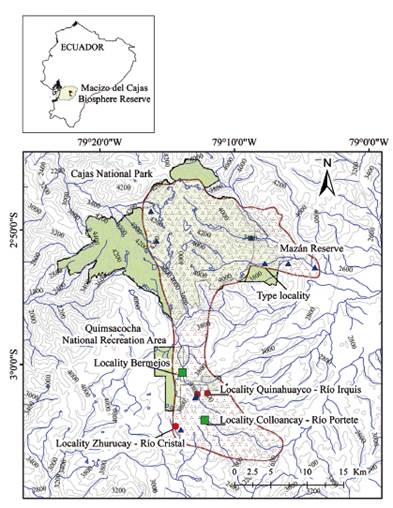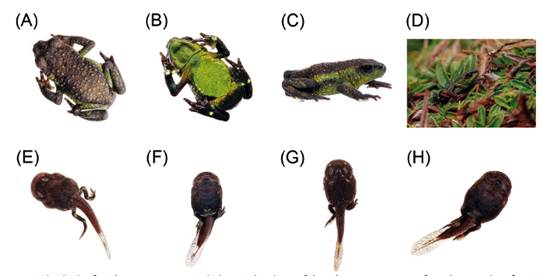Introduction
The human modifications of ecosystems increasingly confine the biodiversity to landscapes with a mosaic of altered habitats (Foley et al. 2005). Particularly, in zones with high levels of species richness, endemism and concentrations of threatened species, biodiversity is more sensitive to human-induced changes to natural habitats (Sala et al. 2000). For instance, endemic frogs, such as species of Atelopus (endemic to the Neotropical region) have been greater predicted extinction risk as a consequence of global climatic change as well as disease such as the pathogenic chytrid fungus (Pounds et al. 2006, Roach et al. 2020, Urgiles et al. 2021). Atelopus exiguus is a critically endangered endemic (Ortega-Andrade et al. 2021) found in both páramo grassland and montane forest in only a few highland localities (elevation range: 3000 - 4000 m a.s.l.) of the Macizo del Cajas Biosphere Reserve (MCB) in the western Andean cordillera of Azuay province, southern Ecuador (Ron et al. 2018). The type locality of A. exiguus is Zurucuchu valley (2°50’34.8” S, 79°8’45.6” W; 3150 m a.s.l.) located in the Cajas National Park (CNP); additional localities have been reported beyond to the limits of another protected area south of CNP, Quimsacocha National Recreation Area (ARQ), near to Tres Lagunas (3°2’29.58” S, 79°12’56.41”, 3760 m a.s.l.) and Zhurucay (3°4’55.20” S, 79°13’59.63” W, 3675 m a.s.l) for example (Ron et al. 2018, Coloma et al. 2000). Within respect to the known geographic range, little attention has been given to identifying new localities in addition to the historical records - e.g., Mazán Reserve, CNP (Maldonado 2010), given that Atelopus species are a priority taxon to monitor and conserve (Roach et al. 2020). Therefore, it is crucial to publish new occurrences along with detailed habitat descriptions of A. exiguus to update knowledge and to identify localities of interest for conservation.
Material and methods
Within the current known geographic range of A. exiguus, particularly in the páramo habitats (> 3500 m a.s.l) of MCB (Fig. 1), southern Ecuador, we performed intensive surveys for the species across 15 localities (elevation range: 3550 - 3800 m a.s.l.) between September 2020 and August 2021. The localities are within the core area of MCB (2°55’25” S, 79°21’57” W), including páramos inside of ARQ and its buffer páramo-areas (within a radius of ~10 km). The localities were selected based on similarities in habitat to areas where past records in the study area were found (Fig. 1). In each locality, we installed a transect along the banks of streams and small rivers. Each transect was 150 m in length and 50 m in width (total area = 7500 m2). We monitored all substrates, including moving rocks and logs inside the water body as well as searches in bunch-grass species of Chalamagristis (páramo grassland habitat), cushion plants such as Plantago rigida and Oreobous ecuadorensis (cushion páramo) and shrubs plants such as Monticalia, Hypericum and Valeriana species (shrubby páramo) as principal riparian vegetation. Each locality was surveyed once per month for a minimum of three hours, always during the day due to the species’ diurnal habits (9:00 - 17:00 h). All surveys were performed by at least two observers. All individuals recorded were identified and photographed in situ. No individuals were collected (not authorized by the Ecuadorian deputy of environment). For species identification, we used the descriptions of Coloma et al. (2000) and Ron et al. (2018). Individuals were recognized as A. exiguus by their relatively small size, dark brown dorsum and flanks with yellowish-green spots, black irises, poorly developed palmar tubercles, and snout pointed from above; while the tadpoles were recognized by the elongate-ovoid body, the greatest width at the posterior part of body, body slightly constricted at eye level, robust caudal musculature, and translucent marks posterior to eyes (Fig. 1). In addition, we performed aquatic macroinvertebrate surveys to estimate the biological water quality (Andean Biotic Index [ABI] Rios-Touma et al. 2014) and therefore habitat requirements of the species. We followed the macroinvertebrate monitoring protocol developed for the study area (for more details see Jiménez et al. [2021]).

Figure 1 Map of the study area and location of the new and previous occurrences of Atelopus exiguus across the páramo ecosystem of southern Andes of Ecuador (Azuay province). The filled-green squares are the new records from this study. The filled-red circles are unpublished previous occurrences, deposited in the data base of Universidad del Azuay by JC. Sánchez-Nivicela & G. Samaniego (2009-2010). The filled-blue triangles are the occurrences documented by Ron et al., (2018). The brown polygon with dots is the geographic range of A. exiguus (UICN 2018).
Results
In one year of monitoring, we only recorded A. exiguus in two localities (Fig. 1). In total, we recorded four individuals (Fig. 2). On 11 June 2020, in the locality of Bermejos (3°00’32.16” S, 79°13’51.25” W; 3724 m a.s.l.), we recorded a frog (Fig 2A-C) as well as one tadpole (Fig 2E-F); the individuals were found between rocks, partially cover by the water flow, near to the bank of a stream which is part of headwaters of Bermejos hydrological system. In the same locality, on 20 November 2020, we photographed a frog (Fig 2D), the individual was recorded ~10 m from the banks of the stream in cushion páramo. Finally, on 1 December 2020, in Colloancay (3°04’03.77” S, 79°12’12.33” W; 3572 m a.s.l.), we recorded a tadpole (Fig 2G-H) in the muddy-rocky bottom of the stream that is part of the headwaters of Portete hydrological system. All tadpoles were found opportunistically during the macroinvertebrate surveys.
The locality of Bermejos is characterized as a habitat dominated by páramo grassland (50%) in association with shrubby páramo (20%) as well as cushion páramo in lower proportion (5%), the remaining 25% represents the water body; water flow was seasonal throughout the year (min [Nov.] = 0.1 m3 s -1, max [Abr.] = 2.2 m3 s -1, average = 0.9 m3 s -1) with relatively small temperature variation (min [Nov] = 9.8°C, max [Dec.] = 12.7°C, average = 11.5°C) and water quality, at the moment of the record was estimated to be between medium (ABI [June] = 57) and very good (ABI [Nov.] = 98). The locality of Colloancay is a wetland dominated by páramo grassland (55%) with a lower proportion of shrubby páramo (20%) as well as cushion páramo (5%), the final 20% represents the water body; water flow was lower throughout the year but more consistent (min [Oct.] = 0.1 m3 s -1, max [Abr.] = 0.9 m3 s -1, average = 0.4 m3 s -1), also with little variation in the temperature (min [Nov.] = 11.5, max [Jun] = 13.1°C, average = 12.5°C) and the water quality at the moment of the record was good (ABI [Dec.] = 65).

Figure 2 Individuals of Atelopus exiguus recorded in two localities of the páramo ecosystem of southern Andes of Ecuador (Azuay province). A-D are two individuals photographed in the locality of Bermejos. A-C (dorsal, ventral, and lateral view respectively) is an individual photographed on 11 June 2020; D is an individual photographed on 20 November 2020. E-F (dorsal and ventral view respectively) is a tadpole photographed on 11 June 2020. G-H (dorsal and ventral view respectively) is a tadpole photographed in the locality of Colloancay on 1 December 2020 (all photos: BT). For localities see Fig. 1.
Discussions
Our findings are the first record for ARQ (i.e., Bermejos) as well as indicating that there are indeed localities beyond the limits of the protected areas with suitable habitat for A. exiguus. More importantly, as far as we know, our results are the first approximation towards a habitat description for this species in the páramo ecosystem.
Before our study, one of the most complete monitoring efforts for A. exiguus came from Maldonado (2010). The study was carried out in the montane forest habitats of Mazán Reserve (3100 m a.s.l.) and recorded 14 individuals (seven adult-males, one adult-female and six sub-adults). Maldonado (2010) provided a very fine description of montane habitat, including humid pastures in association with woody shrubs as well as less proportion of tress always near to the banks (~ 2 m) of small tributaries of the Mazán river, with temperature range from 11 to 14.2°C. This study conclude that Mazán Reserve is one the most suitable habitats for A. exiguus. However, despite several previous records of A. exiguus across the study area (Fig 1), no record is accompanied by a formal protocol or habitat descriptions. Thus, our findings demonstrate that in addition to montane forest habitats, páramo habitats are important. Particularly, riparian vegetation in the form of open and semi-open páramo (elevation range: 3500 - 3750 m) in combination with slower moving streams with relatively good water quality (according to ABI) and low temperature water is suitable habitat.
An important factor in Atelopus species extinctions globally is the increasing presence of a pathogenic chytrid fungus linked to global climate change (Pounds et al. 2006). The optimum growth of this pathogenic fungus is predicted in ranges from 17 to 25°C (Pounds et al. 2006). Our results indicate that the microhabitat conditions of A. exiguus across the study area are less favourable for the development of this fungus as the water temperatures were < 13.1°C. However, close to Bermejos, Urgiles et al. (2021) reported the presence of chytrid fungus on Pristimantis species. Due to the fungus’ association with decreasing amphibian populations, and the predicted dramatic climatic shifts in the high Andes region with associated higher chytrid fungus prevalence (Urgiles et al. 2021), it is evident that more studies are needed. Thus, monitoring water quality and temperature is a key element to consider within further monitoring programs across montane and páramo habitats (Roach et al. 2020). Besides, the presence of individuals including tadpoles, our results may suggest that the new localities are suitable reproductive habitat. For better and more comprehensive monitoring-conservation programs, an interdisciplinary effort is required to fully understand ecological and habitat requirements for A. exiguus. Here, intensive surveys beyond the limits of protected areas of Azuay province, focused within the páramos, are emerging as urgent steps to improve conservation decisions for threatened species such as Andean frogs belonging to the A. bomolochos group such as A. exiguus and A. nanay.












 uBio
uBio 


